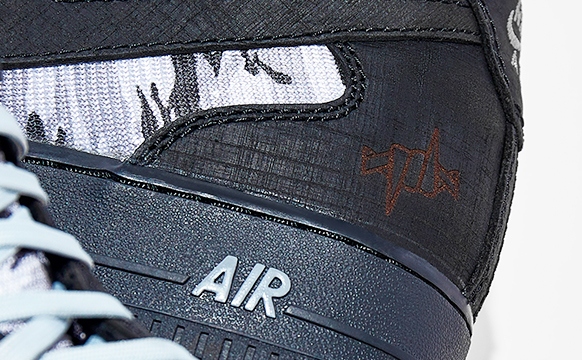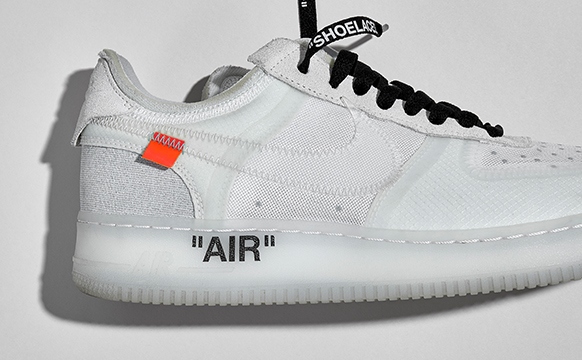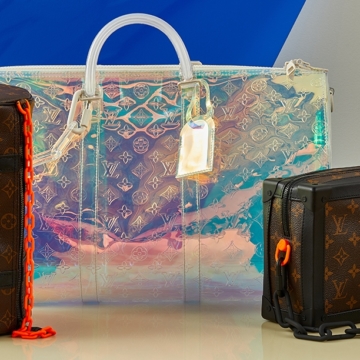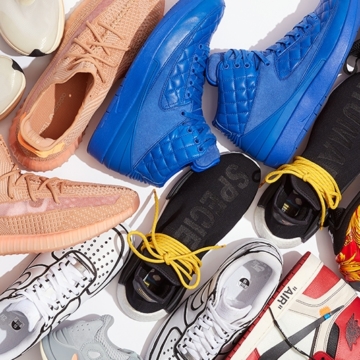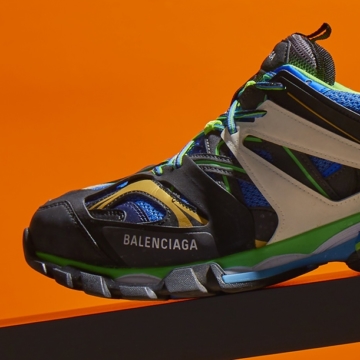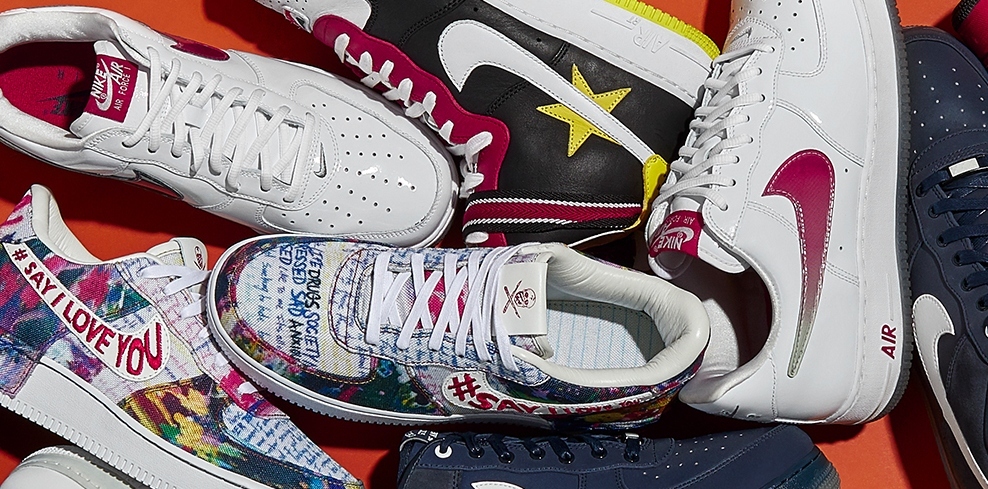
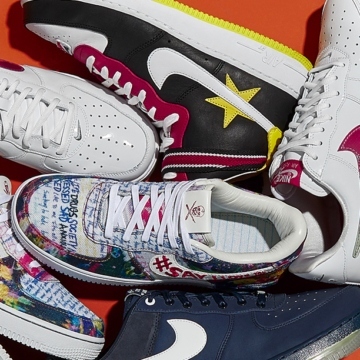
Nike Air Force 1: the Birth Of a Super Sneaker
Few sneakers can compete with the cultural magnitude, classic look and mass appeal of the Air Force 1. Since its release, the basketball shoe has surpassed the sneaker giant’s wildest dreams of success, transforming into a hip-hop icon, artist canvas and everyday staple. A marriage of superior construction, groundbreaking technology and understated lines sets it apart from the crowd, but it’s a little-known fact that the Air Force 1 almost ceased to exist soon after it was created. Read on to discover the shoe’s unique origin story, the details on some of the most coveted brand collaborations, plus Sneaker & Streetwear Valuation Manager Steven Pinkerton’s expert tips for spotting the real deal.
A Force Of Nature Is Born
In the early 1980s, Nike designer Bruce Kilgore was tasked with designing his first-ever basketball shoe. “Kilgore began his career as a tennis shoe designer, giving sneakers like the Nike Air Ace and the Nike Avenger their classic silhouettes,” says Steven Pinkerton, Sneaker & Streetwear Valuation Manager. Designing a shoe that would perform well on the basketball court, however, was an entirely different ballgame.
“Kilgore was worried about the shoe’s stability, but he drew architectural inspiration from an unlikely source — Notre-Dame Cathedral,” says Pinkerton. “He translated this design by angling the sole so it would create a larger contact point with the court. Then he devised the tread pattern of concentric circles on the sole, so that players could easily pivot.” The Air Force 1 was also Nike’s first “slip-lasted” shoe, using a method of construction that entails pulling the shoe’s upper over a last (a foot-shaped mold) and then attaching it to the midsole.
The Air Force 1 was also the first basketball shoe to feature Nike Air technology, which was based on a system developed by aerospace engineer Frank Rudy. Advertisements at the time displayed a cross-section diagram of the Air Force 1, revealing a pocket of air within the sole. “The original prototype included a metal shank, placed beneath the airbag to give it more spring,” adds Pinkerton. “It was removed, however, for liability reasons.”
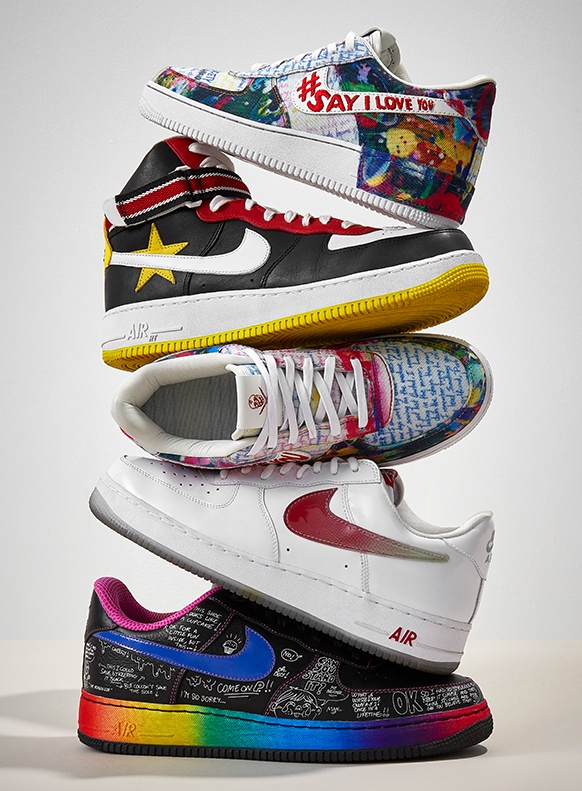
Top to bottom: The Shoe Surgeon x Nike Air Force 1 “Say I Love You” Sneakers; Riccardo Tisci x Nike Air Force 1 All-Star; Nike 2018 Air Force 1 Low Taiwan Sneakers; Nike Air Force 1 Low Colette x Busy P Sneakers
The result of Kilgore’s efforts was a cushioned high-top sneaker with a removable ankle strap and a contrasting Swoosh (the low-top was released a year after the 1982 release). Its impact on urban communities was immediate and monumental. Basketball player Moses Malone led the Philadelphia 76ers to victory in 1983 wearing the Air Force 1s, cementing the shoe as legendary in the local history books. It was the ideal choice for shooting hoops and looking “fresh to death” in cities such as New York and Baltimore as well. But like all sneakers in the ’80s, the Air Force 1’s days were numbered.
“Nike was planning to discontinue the Air Force 1. It was standard to release a shoe for a certain period and then make way for new styles,” says Pinkerton. Much to sneakerheads’ relief, three Baltimore retailers — Charlie Rudo Sports, Downtown Locker Room and Cinderella Shoes — banded together and met with Nike directly, pleading with the company to resurrect the shoe. Nike agreed, but only if the retailers would place significant orders to merit production. Cinderella Shoes owner Paul Blinken received a shipment of 2,400 pairs in two colorways. They soon sold out. And that was only the beginning.
“Once Nike realized there was love for the Air Force 1 in Baltimore, they launched a program called the ‘Color of the Month Club’ and issued new colorways exclusively to the retailers who made the shoe a part of everyday street culture,” notes Pinkerton. The Air Force 1 became Nike’s first retro release, setting the stage for today’s hype, collaboration-laden sneaker culture.
The Air Force 1: A Blank Canvas For Collaborations
The Nike Air Force 1 Mid Nort Recon Sneakers, a collaboration with graffiti artist Stash.
Distribution of the Air Force 1 expanded throughout the 1990s, and by the 2000s the shoe had been solidified and legitimized in the cultural canon. “The Nike Air Force 1 is an icon on and off the basketball court, but it has played a more significant role off the court,” notes Pinkerton. “Its popularity surged in the early 2000s, in large part because of hip-hop music videos.” In their songs, rappers like Pete Nice, Jay-Z and Nelly name-dropped specific styles like the all-white low-top, a shoe that has inspired its own legion of loyal followers. The shoe’s clean lines, perhaps in tandem with the fresh appeal of the all-white colorway, have given rise to an extant era of collaborations.
“The Air Force 1 is a simple yet intricate design, and its beauty lies in the leather panel placements throughout the shoe,” says Pinkerton. “There are so many different ways to design the Air Force 1, making it the ultimate blank canvas.”
Artists, designers and brands like KAWS, Riccardo Tisci, Supreme and Comme des Garçons have all put their unique spin on the Air Force 1, contributing to a nearly twenty-year legacy of creative expression. “With Nike producing so many colorways and exclusive regional designs, it’s hard to say when the first collaboration was,” admits Pinkerton. “But to my knowledge, the blue and grey 2001 Atmos Nike Air Force 1, a collaboration with Japanese sneaker boutique Atmos, was one of the first. The cultural significance of this collaboration is not to be underestimated. Nike understood how deeply the Japanese appreciated their designs, and laid the foundation for Japanese sneaker culture with this partnership.”
Another important Air Force 1 collaboration is the Mid Nort Recon, designed by graffiti artist Stash. “New York-born artist Stash started painting illegally on subway trains as a kid, and by the age of 17, he was running in the same circles as Keith Haring and Jean-Michel Basquiat,” says Pinkerton. “Stash eventually opened his own shop, Recon, and his work in the streetwear scene was groundbreaking. Former Nike CEO Mark Parker approached him in the early 2000s regarding a collaboration. The Mid Nort Recon was one of the resulting sneakers.”
In line with his store name’s allusion to the military, Stash opted for camouflage panels and scratched leather throughout the sneaker. “The most significant feature of this shoe is the steel-toe construction, reminiscent of a military boot, as well as the barbed wire detail at the shoe’s counter,” notes Pinkerton.
How To Spot Real Nike Air Force 1s
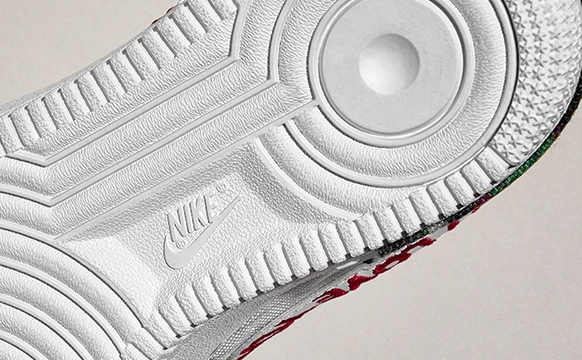
On the majority of Air Force 1s, the Nike logo and Swoosh will be included on the sole.
The Air Force 1 has been released in thousands of colorways, reinterpreted by hundreds of artists and designers and served as a staple on the sneaker scene, so naturally it’s become a prime target for counterfeiters. “When inspecting a Nike Air Force 1 for authenticity, turn it over and look at the bottom of the sole,” says Pinkerton. “Nike will use various logos here, but the most common is the trademark Nike and Swoosh. Check the positions of the registered circled Rs. There should be one above the Swoosh and one at the end of the bold Nike logo.”
On genuine pairs of the Off-White x Nike Air Force 1s, the “AIR” text should align with the heel counter’s edge.
Counterfeiters have also attempted to capitalize on the wildly successful Off-White x Nike: The Ten collection, alongside countless other coveted collaborations. “On authentic Off-White x Nike Air Force 1 sneakers, “AIR” should line up with the curved contrasting accent, right where the heel counter begins,” explains Pinkerton. “The zigzag stitching around the orange tab should be a clean, single line, and the suede Nike tab at the back should not hang lower than the underlay.”
With new colorways and collaborations dropping on a regular basis, such as the Travis Scott x Nike Air Force 1 Low “Cactus Jack” that just released today, the Air Force 1 has established itself as one of the most versatile, adaptable sneaker styles to date. “The Air Force 1 has now been reimagined in countless fabrics and materials, from Goretex to 3M, engineered mesh to flyknit,” says Pinkerton. “The possibilities are truly endless.”
Start stomping in your Air Force 1s — shop our collection here.
All items are pre-owned and consigned to The RealReal. Trademarks are owned by their respective brand owners. No brand owner endorses or sponsors this ad or has any association and/or affiliation with The RealReal.
Please note: Brand standards, logos and other identifying features may have changed since the time of publication.


